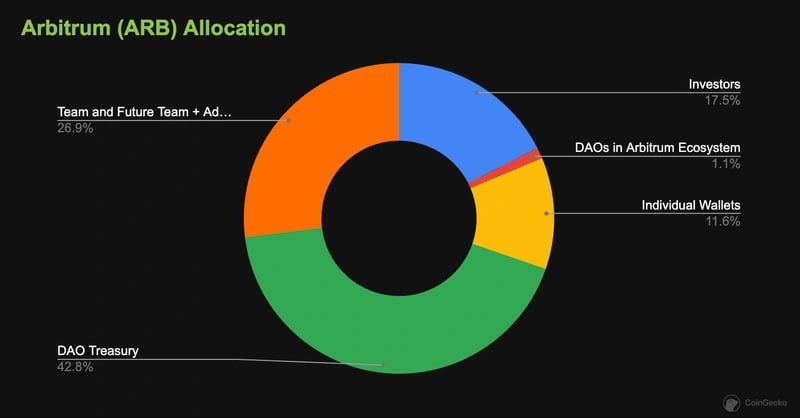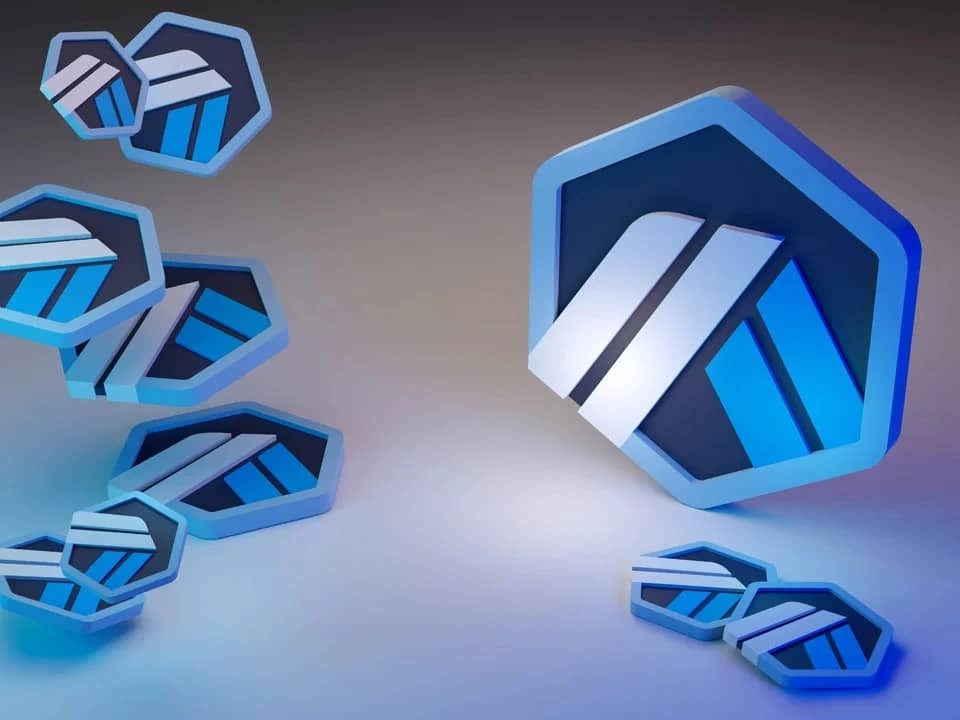위키 구독하기
Share wiki
Bookmark
Arbitrum
Arbitrum
Arbitrum은 Ethereum 확장 솔루션으로 ARB 토큰으로 구동되며, 고처리량, 저비용 smart contracts를 빠르고 안전하게 지원합니다. 이 플랫폼은 개발자가 수정되지 않은 이더리움 가상 머신(Ethereum Virtual Machine, EVM) 계약과 Ethereum 트랜잭션을 2계층에서 쉽게 실행하면서 이더리움의 우수한 1계층 보안을 유지할 수 있도록 설계되었습니다.[1][2] Arbitrum은 Arbitrum DAO에 의해 관리됩니다.
2019년 1월, Arbitrum은 시드 펀딩을 통해 380만 달러, 시리즈 A 펀딩을 통해 2천만 달러를 조달했습니다. 2021년에는 Lightspeed Venture Partners가 주도한 시리즈 B 펀딩을 통해 1억 2천만 달러를 조달했습니다.[3]
2021년 5월, Off-chain Labs는 Arbitrum One의 mainnet 베타 버전을 출시했지만, 개발자들에게만 제공되었으며, 300개 이상의 dApp이 배포되었고 TVL은 10억 달러를 넘었습니다.
2022년 6월, L2 네트워크 Arbitrum One을 대중화하고 사용자를 유치하기 위한 8주 프로그램인 Arbitrum Odyssey가 시작되었습니다. 이 프로그램은 8단계로 구성되며, 각 단계는 Arbitrum 생태계의 다른 측면에 집중합니다.[7]
개요
아르비트럼(Arbitrum)은 저렴하고 빠른 트랜잭션과 완전한 이더리움 스마트 계약 기능을 제공하는 신뢰할 수 있는 2계층 프로토콜입니다. 이더리움 메인 체인에 제출된 트랜잭션 배치를 기록하고 저렴하고 확장 가능한 2계층 사이드체인에서 실행하는 트랜잭션 롤업 기술을 사용하여 이더리움을 활용하여 정확한 결과를 보장합니다. 이 프로세스는 이더리움의 현재 계산 및 저장 부담을 크게 줄이는 동시에 강력한 2계층 기반 DApps의 새로운 종류를 가능하게 합니다.
아르비트럼의 목표는 개발자에게 고효율 및 확장 가능한 이더리움 호환 스마트 계약을 실행하기 위한 사용하기 쉬운 플랫폼을 제공하는 것입니다. 아르비트럼 네트워크에서는 ETH가 트랜잭션 수수료 지불에 사용됩니다. 아르비트럼 네트워크로의 전송은 일반적으로 이더리움으로의 전송보다 90~95% 저렴하며, 수수료를 더욱 줄일 여지가 상당히 많습니다.[9]
아르비트럼은 또한 플랫폼의 맞춤형 가상 머신(AVM)인 자체 가상 머신을 가지고 있습니다. 아르비트럼 가상 머신(AVM)은 아르비트럼 스마트 계약의 실행 영역이며, 아르비트럼 체인과 상호 작용하는 스마트 계약 모음인 EthBridge를 기반으로 구축되었습니다. 이더리움과 호환되는 스마트 계약은 AVM에서 실행되도록 자동으로 변환됩니다.[8]
작동 방식
사용자들이 Arbitrum 체인과 상호 작용하려면, 노드 집합이 트랜잭션을 Arbitrum 시퀀서(정상적인 조건 하에서 L2에 사용자 트랜잭션을 제출하는 책임이 있는 특별히 지정된 Arbitrum 풀 노드(Arbitrum full node))로 전달합니다. 시퀀서는 이더리움 노드처럼 트랜잭션 결과를 보고하지만 훨씬 빠르게 처리합니다. 그런 다음 트랜잭션은 이더리움 블록체인에 기록되어 모든 기본 데이터에 사용자가 액세스할 수 있도록 합니다. 이더리움에서 트랜잭션이 최종성에 도달하면 최종적인 것으로 간주되며 대체하거나 순서를 바꿀 수 없습니다. 이 시점에서 트랜잭션의 결과는 완료됩니다.
이더리움 블록체인에 트랜잭션 데이터가 게시된 후, 트랜잭션 실행은 오프체인으로 이동하여 Arbitrum 검증자에 의해 수행됩니다. Arbitrum 검증자는 어서션(rollup 블록이라고도 함) 형태로 오프체인 처리 결과를 복구합니다. 어서션은 낙관적으로 이더리움 체인에 게시되며, 어서션에 이의가 제기될 경우에만 증명이 첨부됩니다. 검증자는 사기를 치려는 시도가 적발될 경우 몰수될 것이라는 내기를 겁니다. 이는 검증자가 부정직한 행위에 참여하지 않도록 유인책을 제공합니다.
어서션이 게시될 때마다, 어떤 검증자라도 이의를 제기할 수 있는 이의 제기 기간이 열립니다. 다른 검증자는 어서션을 확인하고 잘못된 경우 사기를 증명합니다. 사기를 성공적으로 증명한 검증자는 상당한 보상을 받습니다. 이의 제기 기간이 성공적인 이의 제기 없이 만료되면 정확한 어서션이 확인되고 이더리움에서 승인됩니다. 이는 체인을 검증하는 사람이 정직한 한 Arbitrum이 사기를 방지하는 데 신뢰할 수 있도록 합니다.[12][13]
제품
아비트럼 메인넷에는 두 개의 체인이 작동 중입니다.
Arbitrum One (아비트럼 원)
**Arbitrum One (아비트럼 원)**은 이더리움을 위한 낙관적 롤업 L2 확장 솔루션으로, DeFi 및 NFT에 맞춤화된 빠르고 저렴한 트랜잭션을 제공합니다. 사용자는 Alchemy, Infura, QuickNode, Moralis, ANKR, BlockVision 및 GetBlock을 사용하여 Arbitrum One과 상호 작용할 수 있습니다.
Arbitrum Nova
Arbitrum Nova는 Anytrust 확장 모델을 사용하여 게임/소셜 애플리케이션에 더 적합한 더 낮은 거래 수수료를 제공합니다. Nova는 초저렴 거래에 최적화된 동시에 강력한 보안을 제공하는 Arbitrum AnyTrust 기술 기반의 EVM 호환 체인입니다. Nova는 2022년 8월에 공개되었습니다. Nova는 높은 처리량을 유지하면서 낮은 거래 비용을 필요로 하는 게임 프로젝트, 소셜 계층 또는 모든 애플리케이션에 이상적입니다.
Nova는 Offchain Labs, Reddit, Google Cloud, Consensys 및 FTX를 포함하여 Web2 및 Web3 전반에서 가장 신뢰할 수 있는 조직의 지원을 받고 있습니다.[15][16]
기술
Arbitrum은 개발자들이 빠르게 스마트 계약 및 분산형 이더리움 애플리케이션을 출시하고, 변경 없이 이전 수수료를 낮추고 대역폭을 늘릴 수 있도록 하는 낙관적 롤업(Optimistic Rollups) 개념을 사용합니다. 낙관적 롤업은 트랜잭션을 롤업하는 특정 기술입니다. 속도를 높이기 위해 낙관적 롤업은 롤업에 포함된 트랜잭션이 유효하다고 가정합니다. 이들은 이더리움에 업데이트된 상태를 게시할 때 어떠한 증명도 게시하지 않기 때문에 낙관적입니다.[14]
Arbitrum의 낙관적 롤업은 개인적인 사이드체인에서 처리됩니다. Arbitrum은 트랜잭션을 배치로 수집하여 사이드체인에서 처리한 다음 트랜잭션 데이터를 이더리움 블록체인 원장에 다시 전달합니다.
팀은 Arbitrum을 낙관적 롤업(OR)으로 구축했는데, OR이 안전하고 신뢰할 수 있으며 EVM과 호환되는 L2에 대한 사용자의 현실적인 요구를 충족하는 최선의 방법이라고 믿기 때문입니다.
AnyTrust
AnyTrust는 약한 신뢰 가정을 받아들여 비용을 낮추는 Arbitrum Nitro 기술의 변형입니다.
Arbitrum AnyTrust는 더 낮은 수수료와 교환으로 신뢰 가정을 도입하며, 데이터 가용성은 데이터 가용성 위원회(DAC)에 의해 관리됩니다. DAC는 다음과 같은 고정된 허가된 엔티티 집합입니다.
- Consensys
- FTX
- Google Cloud
- Offchain Labs
- P2P
- Quicknode
파트너
- 체인링크 랩스 (Chainlink Labs)
- 도펙스 (Dopex)
- GMX (GMX)
- 홉 프로토콜 (Hop Protocol)
- 리도 파이낸스 (Lido Finance)
- 라이브피어 (Livepeer)
- 퀵 노드 (Quick Node)
- 시냅스 프로토콜 (Synapse Protocol)
- 트레저 DAO (Treasure DAO)
- 유니스왑 재단 (Uniswap Foundation)
- 언락 프로토콜 (Unlock Protocol)
- 베스타 파이낸스 (Vesta Finance)
- 코인베이스 벤처스 (Coinbase Ventures)
- 판테라 (Pantera)
- 컴파운드 (Compound)
- 블록네이션 (Blocknation).
팀
Arbitrum은 연구원, 엔지니어 및 이더리움 애호가들로 구성된 Off-chain Labs 팀이 개발했습니다. 이 팀에는 암호화, 분산 시스템 및 게임 이론 분야에서 깊이 있는 경험을 가진 전 세계 개발자, 학계 및 운영자 커뮤니티가 포함됩니다.

- Ed Felten - 공동 설립자 겸 최고 과학자
- Steven Goldfeder - 공동 설립자 겸 CEO
- Harry Kalodner - 공동 설립자 겸 CTO
- Lee Bousfield - 수석 소프트웨어 엔지니어
- Rachel Franks - 수석 소프트웨어 엔지니어
- Daniel Goldman - 수석 소프트웨어 엔지니어
- Fred Lacs - 수석 소프트웨어 엔지니어
- Mahsa Moosavi - 소프트웨어 엔지니어
- Daniel Silverberg - 운영 관리자
- A.J. Warner - 파트너십 및 전략 이사
- Hunter Brea - 커뮤니티 매니저
- Nina Rong - 중국 커뮤니티 매니저
- Peter Haymond - 파트너십 매니저
- Size Chad - NFT 및 게임[6]
$ARB 토큰 & DAO 출시
2023년 3월 16일, Arbitrum 재단은 ARB, Arbitrum의 새로운 토큰이 2023년 3월 23일 커뮤니티 회원들에게 에어드롭될 것이라고 발표했습니다. [17]
“오늘, Arbitrum 재단은 Arbitrum One 및 Arbitrum Nova 네트워크에 대한 DAO 거버넌스 출시와 함께 ARB 출시를 발표하게 되어 매우 기쁩니다” –팀이 트윗했습니다
Arbitrum 재단에 따르면, ARB는 Arbitrum의 탈중앙화 자율 조직(DAO)으로의 공식 전환을 의미하며, 따라서 ARB 보유자는 Arbitrum One 및 Arbitrum Nova – 사용자가 Ethereum 블록체인에서 더 빠른 속도와 낮은 수수료로 거래할 수 있도록 하는 네트워크 –을 관할하는 주요 결정에 투표할 수 있습니다. [18][19]
“Arbitrum DAO는 체인 기술 업그레이드 방법부터 체인 수익을 에코시스템 지원에 사용하는 방법까지 핵심 프로토콜 수준의 주요 결정을 통제할 수 있는 권한을 갖게 됩니다” - Arbitrum 재단은 성명에서 밝혔습니다.
$ARB
ARB는 Arbitrum의 네이티브 거버넌스 토큰입니다. 이 토큰은 Arbitrum 네트워크의 거래 수수료 지불에 사용되며 프로토콜의 거버넌스 수단으로도 사용됩니다. $ARB 보유자는 프로토콜 업그레이드 또는 변경 제안 및 투표와 같은 의사 결정 과정에 참여할 수 있습니다.
ARB의 총 유통량은 100억 개입니다. Arbitrum 커뮤니티는 토큰의 56%를 통제합니다 – 에어드롭을 통해 총 공급량의 11.5%가 자격을 갖춘 Arbitrum 사용자에게, 그리고 1.1%가 Arbitrum 생태계에서 운영되는 DAO에 지급됩니다. 나머지 커뮤니티 토큰은 새로운 Arbitrum DAO가 관리하는 재무부로 이동하며, 이를 통해 ARB 보유자는 자금 분배 방법에 대해 투표할 수 있습니다.

AIP-1 논란
2023년 4월 1일, 거의 10억 달러에 달하는 7억 5천만 ARB 토큰을 Arbitrum 재단에 부여하는 제안이 Arbitrum 블록체인 DAO의 토큰 보유자들 사이에서 논쟁을 불러일으켰습니다. 이 제안은 일부 사람들에게 과도하게 광범위한 것으로 여겨졌으며, 재단이 자금에 대해 얼마나 많은 통제권을 갖게 될지에 대한 우려를 제기했습니다. [22]
이 제안은 특별 보조금, 서비스 제공업체에 대한 상환, 그리고 관리 및 운영 비용을 위해 ARB를 관리 예산 지갑으로 이전하려는 것이었습니다. 주말 동안 Arbitrum 커뮤니티 회원들은 투표가 이미 이루어진 결정을 비준하기 위한 것임을 발견했습니다. [23]
- 토큰 보유자의 승인 없이 약 7억 5천만 ARB (8억 8,500만 달러)가 이미 별도의 재무부로 이전되었습니다.
- 재단에 따르면, 4천만 ARB (4,720만 달러)가 "금융 시장의 정교한 행위자"에게 대출로 할당되었습니다.
- 1천만 ARB (1,180만 달러)가 운영 비용으로 법정화폐로 전환되었습니다. [21][22]
Blockworks Research 또한 AIP(Arbitrum 개선 제안) 프레임워크에 반대표를 던지며 다음과 같이 말했습니다.
"우리의 핵심적인 우려는 알 수 없는 지갑 서명자에 의해 통제될 것으로 보이는 7억 5천만 ARB 토큰에 있습니다… 너무 자주 우리는 자금이 불투명한 비용으로 들어가는 것을 보았습니다. DAO 투명성을 우선순위로 삼을 때입니다."
Arbitrum Foundation Response
On April 2, 2023, the Arbitrum Foundation reacted to the controversy by tweeting that its first governance proposal, AIP-1, “likely will not pass” and added its “committed to addressing the feedback received from the community.”
Arbitrum has decided to follow the DAO’s advice and split the AIP into parts, allowing community members to vote on different subsections.
“AIP-1 is too large and covers too many topics. We will follow the DAO’s advice and split the AIP into parts. This will allow the community to discuss and vote on the different subsections.”[20]
It also added that the decision to send 750 million ARB will be voted on in a separate AIP and the team is working on options to add more accountability, such as a four-year vesting period. Further, the team said it would rename the Special Grants program to the “Ecosystem Development Fund,” and add more detail on how the funds will be used.
Arbitrum acknowledged that it should have communicated the proposal better, and confirmed it had used some of the tokens to convert to stablecoins. [21]
“The Foundation does not exist to sell tokens, only sold enough to fund its current operating expenses and has no near-term plans to sell more tokens,” Arbitrum said
The Arbitrum Foundation further pledged it "has no near-term plans to sell more tokens," a nod to the blowback over millions of dollars in ARB it sold for "operational purposes" without community consent. [24]
Arbitrum 새로운 거버넌스 제안
2023년 4월 5일, Arbitrum 재단은 최초의 거버넌스 시도 실패 이후 발생한 논란에 따라 새로운 개선 제안(AIP) 초안을 발표했습니다.
“재단은 DAO가 허용 가능한 예산 및 스마트 계약 잠금 일정을 승인할 때까지 관리 예산 지갑에 남아 있는 7억 개의 토큰을 이동하지 않을 것입니다.” [26]
제안에는 스마트 계약 잠금 일정, 지출, 예산 및 투명성을 다루는 AIP-1.1이 포함됩니다. 다른 제안인 AIP-1.2는 현재 창립 문서에 대한 수정 사항을 다루고 제안 임계값을 5백만 Arbitrum(ARB) 토큰에서 1백만 ARB로 낮춰 “거버넌스에 대한 접근성을 높입니다.”
재단은 또한 “DAO를 가동하기 위해 취한 조치를 설명하는” 투명성 보고서를 발표했습니다. [27]
"우리는 여러분의 피드백을 경청했으며, 재단이 DAO의 최상의 이익을 대표하고 지원할 수 있도록 노력했습니다.
두 개의 새로운 AIP는 Arbitrum 커뮤니티 포럼에 게시되었으며, 계획된 일주일간의 스냅샷 투표 전에 최소 72시간 동안 피드백을 받았습니다. [25][26]
잘못된 내용이 있나요?
